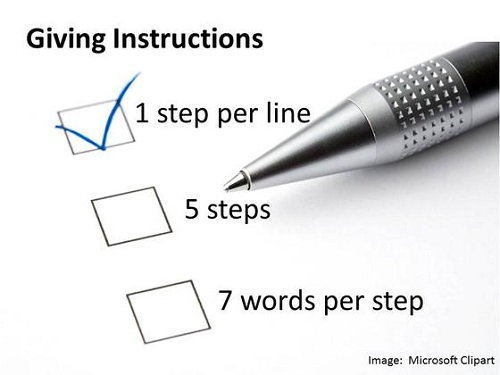Difference Between Directions and Instructions

Directions vs. Instructions
Directions and instructions are exchanges often used by people in everyday situations. People communicate information by giving directions and instructions. Because of their almost identical meanings, the two terms are often used interchangeably.
Both directions and instructions are used as plurals. They can be delivered both in an oral and written manner. The differences between directions and instructions are dependent on the context or usage in a certain situation. Both directions and instructions act as guidelines and often appear as a series of steps or stages. This form implies that one step must be done before proceeding to another in order to complete a task or achieve a desired result.
Directions tend to be associated with places. People often ask for directions when trying to get to a specific geographical location. The most common directional cues are north, south, east, west, top, down, left, and right. Combinations of the abovementioned cues are possible as well. This accomplishes the main goal of getting from one specified area or location to another.
In a different context, directions can also be considered as orders; both provide guidance on what to do. In directions, the manner of delivery is less forceful compared to that of instructions. Directions act as general guidelines with an indication of authority. Additionally, directions do not provide the doer with the context and the result of each step or action.

On the other hand, instructions are also commands or steps needed to make a particular event happen. Instructions are concentrated on how to complete a particular task. They offer context as well as brief explanations of the steps and the succeeding results. These characteristics give instructions some educational value and provide the doer with some understanding of the component’s importance, which is the process itself to the effect of the instructions with all other implied knowledge. Instructions, unlike directions, are detailed and hold a tone of authority in their delivery.
In terms of etymology, “directions” and “instructions” share Latin roots. The word “directions,” comes from ”direction,” while “instructions” is derived from “instructio.” “Instruction” has a later etymology from the late Middle English “instruccio.”
Summary:
1.Both “directions” and “instructions” are a series of orders or steps that need to be taken to achieve a certain goal. In addition, both are words that imply knowledge. They are also nouns that are used as plurals, and their meanings are dependent on the context or situation.
2.Directions are considered less forceful than instructions. Instructions can be more detailed and specific as compared to directions
3.Directions pertain to navigational cues that indicate how to get from one specific place to another. Geographical markers like north, south, east, and west are used in combinations to direct someone to a particular place.
4.Both “direction” and “instruction” have Latin roots. “Direction” comes from the Latin word “direction,” while “instruction” is derived from “instructio.”
5.Both directions and instructions can be communicated in an oral or written manner. In an oral manner, directions or instructions can develop into a conversation or two-way communication. This happens because the recipient can ask for clarification of the given orders or an allowance for comments and feedback. Conversely, dealing with written directions or instructions is a form of one-way communication.
- Differences Between Fraternity And Sorority - January 8, 2014
- Differences Between Lucite and Plastic - January 7, 2014
- Differences Between Oil and Butter - January 6, 2014
Read More ESL Articles
Search DifferenceBetween.net :
Leave a Response
References :
[0]http://englishmilagrosa.blogspot.in/2014/02/giving-directions-in-english.html
[1]http://thinkthematic21c.wikispaces.com/Initiative+%26+Self-Direction
